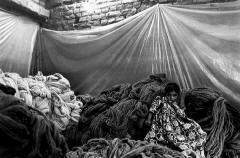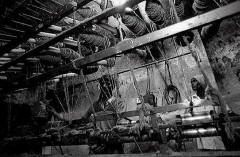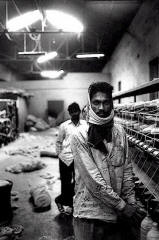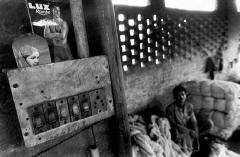Carpet People of India
Photographies by
Adrian Moser
Pressebüro Moser von Graffenried
Zentralstrasse 93
2503 Biel
Switzerland
Mobile +41 (0)79 215 36 45
Phone +41 (0)32 322 27 78
Fax +41 (0)32 322 27 79
moserphoto@bluewin.ch
HOMEPAGE
ADRIAN MOSER
HOME
BIOGRAPHY
CONTEMPORARY ART GALLERY
CONTACT




But soon the temperature will reach up to 40 degrees celsius
Uttar Pradesh is one of the most densely populated districts of India,
a fact which is definitely reflected by this school
Some parents have to 'lend' their sons and daughters to carpet manufacturers,
because they cannot pay back loans which were given freely to them by agents travelling over the villages.
Often these children disappear and never find back to their parents.
The picture above shows a school for former carpet workers, founded by STEP Foundation




Almost every family in
Bhadohi works for the carpet business, be it in producing or trading.
Many
children grow up working with their families.
Aid organizations try not to
outrule child labour as a whole, but they urge European an American
importers to pay fair prices for the carpets.
A decent income for the
parents gives the children the possibility to visit school
The wool has to be cleaned and trimmed before it can enter the spinning process.
The machines in this factory run 24 hours a day.
Nightshift starts 6 p.m. and ends 6 a.m
where textile producing industries no longer have an economic importance.
This machine was built in the 30's of this century.
Accidents during work are quite frequent.




Each shift works for twelve hours








They receive wool and design from the carpet-traders.
Often the design is already preset by the carpet-importers of Europe, America or Japan
Each knot is done manually, resulting in a carpet of tentousands of knots




Carpet producers are well aware of the bad image child-labour has in Europe and America.
So when I showed up with my camera, the children were usually brought away.
These two boys were well hidden behind a weaving-stool
This picture was taken at noon
Any little irregularity is corrected with small scissors


The weaver of a carpet gets less than ten percent of what the exporter gets.
The exporter gets about ten percent of the final price in first world countires
'He's a very important man.' we were told